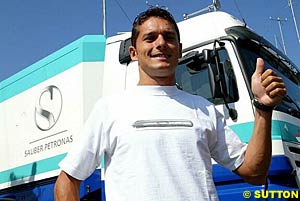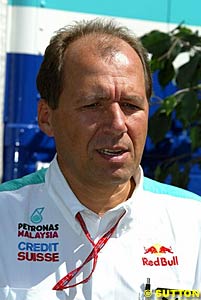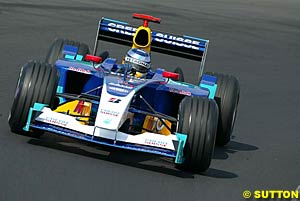
Atlas F1 GP Correspondent
The Sauber team have struggled this season: the Petronas-powered C22 has proved uncompetitive and the points finishes have been few, which is reflected in the Swiss squad's current position in the Championship. But they believe things will change, because when their new, state-of-the-art wind tunnel begins working at the start of next year, they are confident to return to the front. Atlas F1's Will Gray talked to technical director Willi Rampf about Sauber's future and why things are looking bright
Behind the scenes it is all calm on the Sauber front, however.
They are not unhappy with their driver pairing of Heinz-Harald Frentzen and Nick Heidfeld and they are not displeased with their backroom staff. It is just circumstances have necessitated a change. Off track, there are changes afoot as well, but few are leaving because of the poor form and dismal performance that the current Ferrari-engined C22 machine has shown this year. Far from it. In fact, the team are strengthening, growing, and preparing to climb back up the field.
The new full-size wind tunnel, much lauded by the team but as yet unused and unproven, remains the crucial key to their future while their old, out-of-date equipment at their current wind tunnel in Emmen is to blame for their most recent past. To use it to its full potential they need to increase their staff levels and add a few more recruitments to the one that has just filled their racing driver role. The interviews, insiders said, have already begun in the aerodynamic department. And that is why Fisichella knows things are moving forward.
"When I went to the factory I think in the middle of July I saw the new wind tunnel and thought that it is amazing," said Fisichella. "That is very important for the future. I have got a lot of guarantee for the future and I am confident and happy to work with them for next year. They will improve. It must be better than this year. The Ferrari engine is very good and although my target is to race with a top team it is important next year to do my best. Obviously I need a good car but if the car is good and I do my best then maybe I will have a good opportunity in the future."
"We haven't decided yet," said Rampf when asked if Sauber would continue with the C22 next year. "That is one possibility - to start with the current car and to make a revision of the current car. The other is to start a new car. Both solutions are possible and we are working on both."
There is, it seems, certainly a lot to do after the pace of the team's car this season plummeted to a long-term low with just five top ten starts and a measly four top-eight finishes from 13 races leaving them as the lowest points-scoring team on the grid other than Minardi. Last year Heidfeld started from the top ten on the grid in 13 of the 17 races and Massa made three top-ten starts and set off from 11th on the grid on four occasions. Together, they scored 13 top-eight finishes and the team finished fifth in the Championship.
Even then the team were complaining of a mini slump after experiencing their best ever Championship performance with fourth in 2001, when Heidfeld and Kimi Raikkonen recorded 22 top-ten starts and 16 top-eight finishes from a possible 34 including their fifth and Heidfeld's only podium appearance.
Their relatively meager budget provided them with too little resources last year to prevent massive manufacturer Renault from skipping past them in the pecking order. Now the French team have galloped into the distance and Toyota, Jaguar and Honda-backed BAR are all ahead and threatening to do the same. The might of the manufacturers, then, has left Sauber taking their expected place in the 'privateer championship'. But they are behind the struggling Jordan team because of the 10 points Fisichella collected from a surprise lucky win in the rain-hit Brazilian Grand Prix back in March.
"With the C20, which we raced in 2001, we scored almost all the points in the beginning of the season. We had a very good car at the beginning and then, basically, we dropped off a little bit. It seems the developments we can do during the year are smaller than the competition are able to achieve."
Sauber remained notorious for their failure to back up an impressive early-season car with year-long development to keep in on the pace. In 2001 they scored more than half of their 21 points in the opening five races of the year, and in 2002 they scored five of their eight point tally in the same time.
This year they scored eight of their current nine-point total in the first three races of the year but, based on the old scoring system which rewarded the top six rather than the top eight, they would only have with three points for Frentzen's sixth and fifth places in Australia and Brazil.
They have, of course, been hit by the tyre factor, being one of the five teams using Bridgestone tyres this season who have seen Michelin take a running jump forward and become the leading rubber company in Formula One, scoring 351 - or 69 percent - of the 507 points scored so far. That, however, according to Rampf, does not explains it all.
"If you take Ferrari on Bridgestone tyres we can only compare the lap time difference from us to the leader and this is more or less the same as last year," he said. "But we are a bit closer to seventh. Some teams like BAR and Jaguar, they clearly came from behind us and are now leading us. Sometimes when you see the ranking here you get the impression that it is Michelin, two Bridgestone cars and then all Bridgestone. It would be a bit unfair to say that this is only down to the tyre."
As Ferrari have dropped back, so too have Sauber, understandably because they currently use Ferrari's old engine and Bridgestone tyres, even if suggestions that they use the World Champions' transmission continue to baffle Rampf and are totally incorrect.
The biggest thing to blame, it appears, is the antiquity of the wind tunnel that Sauber currently use, which according to one insider uses technology that is five years out of date compared to the rival teams who are rapidly swamping and passing Sauber in the Championship standings.
On top of that, it is understood that Sauber have the least amount of time in that wind tunnel than every other team except Minardi. Even the struggling Jordan team continue to run double shifts in their 40 percent tunnel in Brackley despite their tight budget. Sauber have even made a few trips to the Lola tunnel in England over the last few months to check exactly how poor their own facility in Emmen actually is. Their conclusion, according to one insider, is that the Swiss tunnel cannot measure to accurate enough levels.
In the past development came in large steps, especially when rule changes were introduced and caused teams to make significant alterations to their designs. With stable rules over the last few years, however, Sauber have lost out and fallen behind. Their difficulty in finding small increments in their wind tunnel has gone relatively unchecked over the last few years, noticeable only in their end-of-season tailing off, but is probably responsible for their slow tumble down the Championship table.
The poor aerodynamic performance of the C22 has recently been blamed on inaccurate calibration in the tunnel but, according to insiders, it is not because of any significant mistake this season but rather the fact they cannot detect the tiny improvements that knit together to move the team forward.
"I don't think there is anything wrong with the wind tunnel," said Rampf. "The wind tunnel we are using currently we have used for quite some time. But as the steps of improvement in Formula One get smaller you need a more sophisticated tool to be sure you can achieve very small steps that you can really verify.
"The new wind tunnel we can start in December with the calibration and the aim is to shorten this calibration time as much as possible and to run with the wind tunnel actually beginning testing in February. If we can do that then that would help a lot but the concept has to be decided."
"We have to start with a quite intensive wind tunnel programme to improve the car as soon as possible," added Rampf. "It will be difficult before the first overseas race but then we can implement parts, which we will bring from the wind tunnel to the racetrack.
"We will need more manpower to run it say for longer hours but we know this so we have to gradually build up our aerodynamics department to have more aerodynamicists, more model makers, more model designers, and that is all planned for the future. We cannot start with running it 24 hours per day. We will maybe have two shifts in the beginning but the plan is definitely to have it running for 24 hours, in a long-term plan. That would definitely help to keep us on the pace of development throughout the year."
So that is why Fisichella wanted to go. That and the fact that there was nowhere else to go, with every one of the top manufacturer teams except Jaguar tied up with their drivers for next year. Fisichella has endured a struggling season and has not scored any points other than his Brazil win. But in Hungary, the cheerier Italian admitted: "Now I am happy to sign that contract with Sauber so I hope to show my talent with a better car."
There are still small details like Fisichella's teammate and the confirmation of a continued Ferrari partnership to be confirmed for next year but Sauber, after being blown down this season, can be confident, at least, that once the fan starts in the new tunnel they should rise again.
Giancarlo Fisichella has scored more points himself this season than Swiss-based Sauber team he will be driving for next year -- but he has seen enough to convince him that the struggling former front-runners are on the comeback trail and that they will give him the chance to shine next year.
 Italian Fisichella will not only be a boost for Sauber but is also likely to be the start of a full change for the team next year as rumours grew in Hungary that the signing of Brazilian Ferrari test driver, and former Sauber racer, Felipe Massa is imminent - if not already complete.
Italian Fisichella will not only be a boost for Sauber but is also likely to be the start of a full change for the team next year as rumours grew in Hungary that the signing of Brazilian Ferrari test driver, and former Sauber racer, Felipe Massa is imminent - if not already complete.
 The chance, however, of the car being immediately on the pace rests on an important decision from team boss Peter Sauber and the team's technical chief Willi Rampf ahead of the 2004 season - whether or not to follow McLaren-Mercedes' lead and run a development of the current C22 machine. Just as McLaren failed to find the full potential of their car last year and have developed the MP4-17D machine into a potential World Championship winning car this year, Sauber are currently pondering the possibility that this year they have done exactly the same.
The chance, however, of the car being immediately on the pace rests on an important decision from team boss Peter Sauber and the team's technical chief Willi Rampf ahead of the 2004 season - whether or not to follow McLaren-Mercedes' lead and run a development of the current C22 machine. Just as McLaren failed to find the full potential of their car last year and have developed the MP4-17D machine into a potential World Championship winning car this year, Sauber are currently pondering the possibility that this year they have done exactly the same.
 "I think it has a bit to do with the resources," explained Rampf. "It is the manpower, the money, the wind tunnel hours. I think that some teams have about three times the amount of wind tunnel hours that we have so there is no reason why they should have smaller steps or equal steps than we do. I think the step over the winter time from C21 to C22 was not big enough to be quite competitive from the beginning and also some other teams have made bigger steps. Teams that have been behind us, really behind us, last year are now between us and the leaders.
"I think it has a bit to do with the resources," explained Rampf. "It is the manpower, the money, the wind tunnel hours. I think that some teams have about three times the amount of wind tunnel hours that we have so there is no reason why they should have smaller steps or equal steps than we do. I think the step over the winter time from C21 to C22 was not big enough to be quite competitive from the beginning and also some other teams have made bigger steps. Teams that have been behind us, really behind us, last year are now between us and the leaders.
 They receive no technical help, however, from the Italian giants and, when asked if Rampf believes it is their close relationship with Ferrari has been part of their downfall he replied: "We just use the engine and the electronics to control the engine. That is all the input we get, so no, I don't think so."
They receive no technical help, however, from the Italian giants and, when asked if Rampf believes it is their close relationship with Ferrari has been part of their downfall he replied: "We just use the engine and the electronics to control the engine. That is all the input we get, so no, I don't think so."
 That points towards running with the current car at the start of next season and, with budgets not big enough to allow a fully new car to be developed for the middle of next season, they appear to be hoping the new tunnel will give them the opportunity to gather those increments and leap forward again.
That points towards running with the current car at the start of next season and, with budgets not big enough to allow a fully new car to be developed for the middle of next season, they appear to be hoping the new tunnel will give them the opportunity to gather those increments and leap forward again.
Please Contact Us for permission to republish this or any other material from Atlas F1.
|
Volume 9, Issue 35
Atlas F1 Exclusive
The Winds of Change
Ann Bradshaw: View from the Paddock
2003 Hungarian GP Review
2003 Hungarian GP Review
Hungarian Ups and Downs
The Turning of the Season
Stats Center
Qualifying Differentials
SuperStats
Charts Center
Columns
Season Strokes
On the Road
Elsewhere in Racing
The Weekly Grapevine
> Homepage |